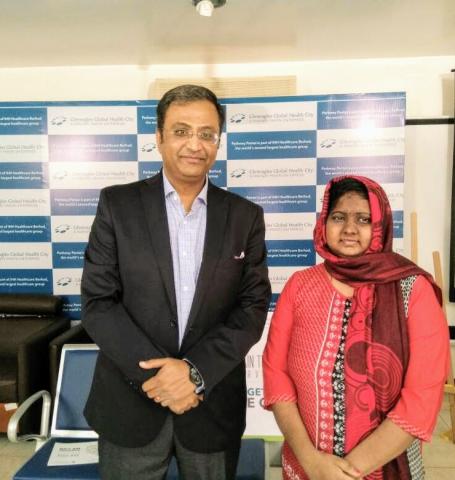
Pavithra Sakthivel, who had severe headaches and a seizure, was diagnosed with Grade 3 malignant brain tumor. But she recovered quickly in six months. Find out about the treatment and surgical options that worked for her.
I am a 36 year old teacher and an Education Specialist. I was leading a happy, healthy life with my husband and cute 6 year old son till January 2017. Trouble began when I started getting headaches. Initially, they were appeared routine, but grew in frequency and intensity within weeks. By the end of the month, my head had begun to throb unbearably, as if somebody was pounding on it mercilessly. I was unable to do anything most days, except cradle and clasp my head in agony. I tried some home remedies like steam and oil massage, but the pain continued nonstop. I went to the doctor for an eye check-up and popped in some paracetamol, but nothing brought relief.
Must Read: Don't Ignore Behavioural Changes
In early Feb, even as I continued to grapple with my headaches, a disturbing incident took place. I had a seizure attack. I have never had one before. I do not remember what happened to me that morning. But my husband, who was partially awake, tells me that I had suddenly started convulsing in bed. My eyes had rolled up, my lips were awkwardly twisted, my teeth were clenched, and my whole body was shaking with fits. I had seizures for two minutes. My husband had immediately rushed me to the nearby Gleneagles Global Hospital, Chennai. When I regained consciousness, I found myself in the emergency ward.
At the hospital, the attending doctors asked me about my symptoms. They wanted to find out if I had experienced any memory loss, mood swings or slurring of speech. But I had no such incidences. The only symptom I had was headaches, and now a seizure. Finally, an MRI was done. The findings really shook me. I had been diagnosed with an Anaplastic Astrocytoma Brain Tumor Grade 3, a rare malignant brain tumor that is fast-growing and spreads into the surrounding tissues, making surgery difficult. The whole diagnosis was scary for me and my family. I had never thought, not even in my wildest fears, that one day I would be down with a tumor in the brain, battling for survival. It was horrifying. I thought I was going to die. I was most worried about my family, particularly my little son.
But the people who put me and my family at ease were Dr K Sridhar, Director, Neurosciences & Head of Department, and his team. They patiently explained to us the whole procedure, and pumped us with confidence and hope. We felt calm and reassured that all would be fine.

Image above: Pavithra in a red Indian dress standing next to her surgeon Dr. K. Sridhar
On 20 February, with heaps of conviction and faith in Dr K Sridhar and God, I underwent the ‘Awake Craniotomy surgery’. This is an advanced neurosurgical technique and type of craniotomy (temporary removal of a small portion of skull bone) that allows a surgeon to remove a brain tumor while the patient is awake to avoid brain damage. I remember, the doctor and his team kept talking to me through the surgery. Subsequently, I had to go through radiation and chemotherapy.
Six months post my surgery, I was back to normal and happy to be playing with my son again.
In June 2017, Dr Sridhar launched ‘Connect – a Brain Tumor Support Group’ to spread awareness about the disease and treatment, and to connect individuals. I am an active member of that group. In fact, my recovery was so good that I was able to give a dance performance for 5 minutes at one of its sessions. I had gone up on stage as a beacon of hope for others. I wanted to tell others that an occurrence of a brain tumor does not mean the end of life. If detected early, it is not a life-threatening disease. With medical advances and qualified specialists, you can lead a normal, healthy life even post-surgery.
Today, I am really grateful to Dr Sridhar and his team for saving my life.
Dr. K. Sridhar adds:
Brain Tumours can occur at any age. They present with symptoms of reduced function of the brain (eg weakness of limbs, difficulty in speech, decreased vision, altered behaviour, incoordination etc), of hyperactivity of the brain (eg fits), or those suggestive of increased pressure in the head (headache with vomitiong, double vision etc.) It is easy to diagnose brain tumours with modern day CT and MRI scans. Most brain tumours need to be removed by surgery as this is the definitive treatment. Surgery for brain tumours is now safe with a risk of less than 3 per cent in majority of cases. Surgery needs to be followed by radiation therapy and medications depending on whether the tumour is cancerous or non-cancerous. Either way the best chance for a patient to do well when diagnosed with a brain tumour is to have early surgery. An integrated approach towards management of patients with brain tumours is important for achieving good results.
Prof.Dr. K. Sridhar is Head Department of Neuro Surgery, Director, Institute of Neurological Sciences and Spinal Disorders at Gleneagles Global Health City






